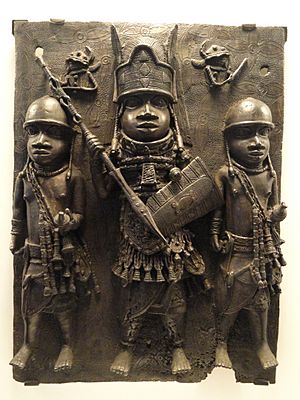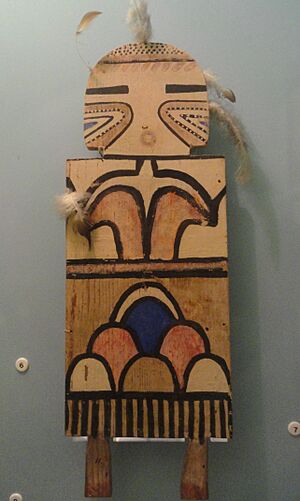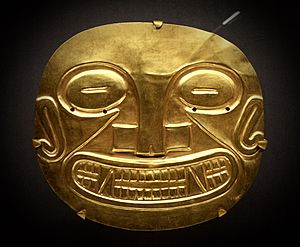Peabody Museum of Archaeology and Ethnology facts for kids

Peabody Museum of Archaeology and Ethnology, Harvard University
|
|
| Lua error in Module:Location_map at line 420: attempt to index field 'wikibase' (a nil value). | |
| Established | 1866 |
|---|---|
| Location | Harvard University Cambridge, Massachusetts |
| Type | Archaeology museum Ethnographic museum |
| Accreditation | American Alliance of Museums |
| Founder | George Peabody |
| Owner | Harvard University |
| Public transit access | Harvard (MBTA) |
| Nearest parking | Street |
The Peabody Museum of Archaeology and Ethnology is a museum at Harvard University in Cambridge, Massachusetts. It is one of the oldest and largest museums about human cultures in the world. The museum focuses on archaeology (the study of past people through objects) and ethnography (the study of different cultures).
Founded in 1866, the museum takes care of over 1.2 million objects. It also has a huge collection of documents, maps, and about 500,000 photographs. The Peabody is one of four Harvard Museums of Science and Culture that are open to the public.
Contents
History of the Museum
The museum was created with a gift from George Peabody, a wealthy businessman, on October 8, 1866. He gave $150,000 to create a professor position, buy artifacts, and build a museum to hold them. He wanted the building to be fireproof and built on land given by Harvard University.
The museum's first exhibit opened in 1867. It showed ancient artifacts found in the Merrimack Valley. In 1877, the museum's own special building was finally finished. The building was made larger in 1888 and again in 1913 to make room for more collections.
Amazing Collections from Around the World
The Peabody Museum holds collections that tell the story of human history from millions of years ago. The items come from all over the world, with a special focus on the Americas and the Pacific Islands.
North America
The museum has a huge collection of items from Native American cultures. These artifacts span 10,000 years of history. The collection includes beautiful baskets from California and items from the famous Lewis and Clark expedition.
Central America
This collection features items from ancient civilizations like the Maya. You can see stone sculptures from famous sites like Copán and amazing artifacts recovered from the Sacred Cenote (a natural well) at Chichen Itza.
South America
The South American collection includes colorful feather headdresses from the Amazon Basin. It also has beautiful textiles from the Andes mountains and pottery from ancient cultures like the Moche and Nazca.
Africa

With over 20,000 items, the African collection shows the daily and ceremonial life of people from countries like Liberia and Uganda. It includes over 200 musical instruments, such as drums and hand pianos. There are also ancient artifacts from Egypt and Nubia.
Asia and Oceania
The Asian collection has items from the Ainu people of Japan and beautiful ceramics from China. The Oceania collection, from the Pacific Islands, has over 23,000 items. These include carved wooden statues from Easter Island and feather cloaks from Hawaii.
Other Collections
- Europe: The museum has stone tools from the Stone Age and artifacts from the Iron Age. Some items come from a time when Cro-Magnon people lived in France.
- Paintings and Drawings: The museum holds nearly 200 paintings and many more drawings. Many of these artworks show Native American life and leaders, painted by artists like George Catlin and Seth Eastman.
- Archives: The museum keeps records and photos from over 70 expeditions. These archives help researchers understand the stories behind the artifacts.
Museum Exhibits
The Peabody Museum has several exhibits you can visit to learn about different cultures and history.
Permanent Exhibits
- Hall of the North American Indian: This hall explores the cultures of Native Americans. It shows how their lives changed after Europeans arrived.
- Day of the Dead: This exhibit features a colorful altar, or ofrenda, for the Mexican holiday Day of the Dead. It shows both the ancient Aztec roots and modern traditions of the celebration.
- Digging Veritas: Learn about the lives of students at Harvard hundreds of years ago. This exhibit uses archaeological finds from the university's own campus.
- Encounters with the Americas: This gallery explores the native cultures of Latin America before and after Christopher Columbus arrived in 1492.
Past Exhibits
- All the World Is Here: This exhibit celebrated the museum's early history and its part in the 1893 World's Fair in Chicago. It showed over 600 objects from around the globe.
- Wiyohpiyata: Lakota Images of the Contested West: This special exhibit used sound, motion, and art to bring 19th-century Lakota drawings to life. It told the story of westward expansion from the Lakota people's point of view.
See also
 In Spanish: Museo Peabody de Arqueología y Etnología para niños
In Spanish: Museo Peabody de Arqueología y Etnología para niños



